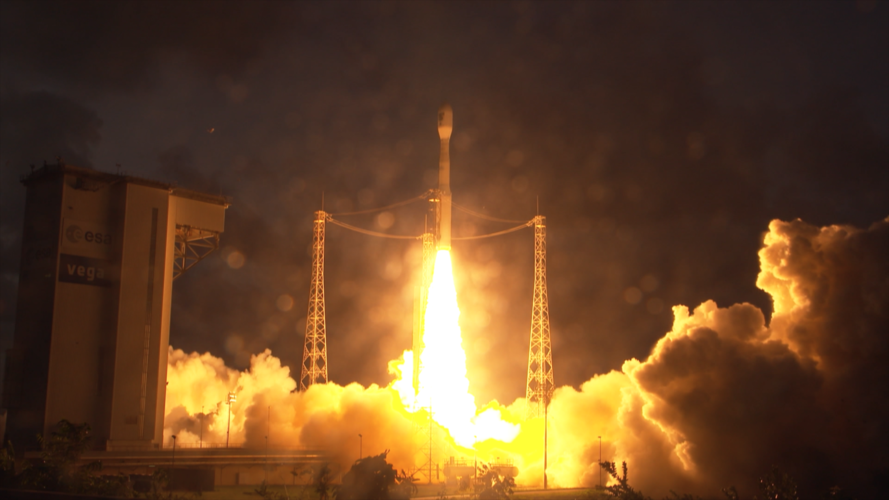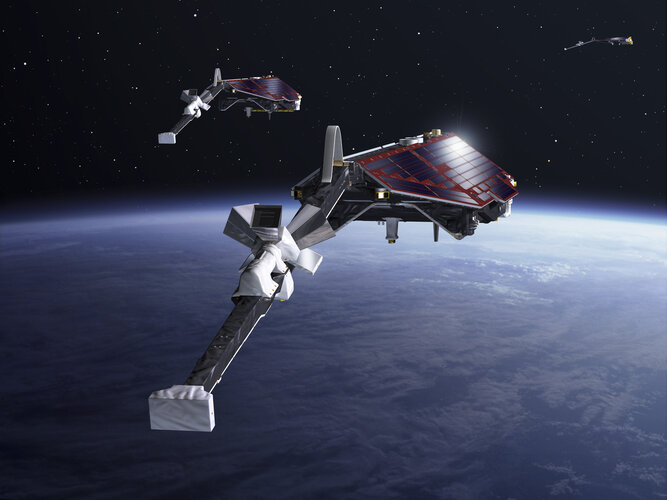
Copernical Team
Vega-C liftoff and return-to-flight
 Video:
00:04:20
Video:
00:04:20
Relive the Vega-C launch, flight VV25, from various angles.
The third Copernicus Sentinel-1 satellite, Sentinel-1C, has launched aboard a Vega-C rocket, flight VV25, from Europe’s Spaceport in French Guiana. The rocket lifted off on 5 December 2024 at 22:20 CET (18:20 local time).
Sentinel-1C extends the legacy of its predecessors, delivering high-resolution radar imagery to monitor Earth’s changing environment, supporting a diverse range of applications and advance scientific research. Additionally, Sentinel-1C introduces new capabilities for detecting and monitoring maritime traffic.
The launch also marks Vega-C’s ‘return to flight’, a key step in restoring Europe’s independent access to space. Vega-C is the evolution of the Vega family of rockets and delivers increased performance,
Swarm vs. space radiation – the first 10 years

Satellites in orbit can become absentminded. Space radiation randomly flips onboard memory bits, potentially corrupting mission data and functionality. To better understand how this invisible onslaught works in practice, a team systematically analysed how radiation affected the memories of ESA’s three Swarm spacecraft during a decade of mapping Earth’s magnetic field.
Sentinel-1C captures first radar images

Less than a week after its launch, the Copernicus Sentinel-1C satellite has delivered its first radar images of Earth – offering a glimpse into its capabilities for environmental monitoring. These initial images feature regions of interest, including Svalbard in Norway, the Netherlands, and Brussels, Belgium.
XMM-Newton celebrates 25 years of breakthroughs

Today, ESA’s powerful X-ray observatory, XMM-Newton, celebrates 25 years in space. From planets to black holes, the space telescope has delivered many ground-breaking observations of a variety of celestial objects. And the mission is still going strong as recent results testify. We take a look at five fascinating discoveries from the last five years.
China boosts Lunar and Mars mission capabilities with advanced Long March rockets
 China's Long March 10, the next-generation manned launch vehicle, is set to significantly enhance the nation's lunar mission capabilities, increasing its lunar transfer orbit payload capacity from 8.2 tonnes to an impressive 27 tonnes. This development was announced by Long Lehao, a senior rocket designer at the China Academy of Launch Vehicle Technology (CALT).
Long March 10 is designed t
China's Long March 10, the next-generation manned launch vehicle, is set to significantly enhance the nation's lunar mission capabilities, increasing its lunar transfer orbit payload capacity from 8.2 tonnes to an impressive 27 tonnes. This development was announced by Long Lehao, a senior rocket designer at the China Academy of Launch Vehicle Technology (CALT).
Long March 10 is designed t Space-time crystals enable advances in optical materials
 Photonic time crystals, materials with consistent spatial composition but periodically varying properties over time, offer innovative pathways for optical information processing. These materials can modulate and amplify light's spectral composition, enabling advanced functionality. "This gives us new degrees of freedom but also poses a lot of challenges," said Professor Carsten Rockstuhl from Ka
Photonic time crystals, materials with consistent spatial composition but periodically varying properties over time, offer innovative pathways for optical information processing. These materials can modulate and amplify light's spectral composition, enabling advanced functionality. "This gives us new degrees of freedom but also poses a lot of challenges," said Professor Carsten Rockstuhl from Ka Space42 and ICEYE partner to manufacture SAR satellites in UAE
 Space42 (ADX: SPACE42), a leading UAE-based AI-driven SpaceTech firm, and ICEYE, a global authority in Synthetic Aperture Radar (SAR) satellite operations, have announced a joint venture to produce SAR satellites in the UAE. This partnership builds on their collaboration, highlighted by the successful launch of the UAE's first SAR satellite, Foresight-1, in August 2024.
The joint venture f
Space42 (ADX: SPACE42), a leading UAE-based AI-driven SpaceTech firm, and ICEYE, a global authority in Synthetic Aperture Radar (SAR) satellite operations, have announced a joint venture to produce SAR satellites in the UAE. This partnership builds on their collaboration, highlighted by the successful launch of the UAE's first SAR satellite, Foresight-1, in August 2024.
The joint venture f Webb Telescope unveils unexpected details in Spiderweb Protocluster
 A team of international astronomers has used the NASA/ESA/CSA James Webb Space Telescope to uncover previously hidden galaxies in the Spiderweb protocluster. These findings challenge earlier assumptions about the role of gravitational interactions in dense cosmic regions, offering fresh insights into galaxy formation within these large-scale structures.
The Spiderweb protocluster, a well-d
A team of international astronomers has used the NASA/ESA/CSA James Webb Space Telescope to uncover previously hidden galaxies in the Spiderweb protocluster. These findings challenge earlier assumptions about the role of gravitational interactions in dense cosmic regions, offering fresh insights into galaxy formation within these large-scale structures.
The Spiderweb protocluster, a well-d Robotics microbiology and agriculture dominate ISS research this month
 The International Space Station (ISS) wrapped up the week with a focus on robotics, microbiology, and space agriculture as the Expedition 72 crew tackled an intensive schedule of scientific investigations and maintenance. Preparations for an upcoming spacewalk and continued work on the station's systems rounded out the crew's activities.
NASA astronaut and station commander Suni Williams c
The International Space Station (ISS) wrapped up the week with a focus on robotics, microbiology, and space agriculture as the Expedition 72 crew tackled an intensive schedule of scientific investigations and maintenance. Preparations for an upcoming spacewalk and continued work on the station's systems rounded out the crew's activities.
NASA astronaut and station commander Suni Williams c BepiColombo achieves milestone with mid-infrared observations of Mercury
 On December 1, 2024, the European Space Agency's BepiColombo mission completed its fifth flyby of Mercury, marking a historic first by capturing the planet in mid-infrared light. The unprecedented images provide fresh insights into the temperature and mineral composition of Mercury's cratered surface.
Mercury, the least-explored terrestrial planet in the Solar System, has only been visited
On December 1, 2024, the European Space Agency's BepiColombo mission completed its fifth flyby of Mercury, marking a historic first by capturing the planet in mid-infrared light. The unprecedented images provide fresh insights into the temperature and mineral composition of Mercury's cratered surface.
Mercury, the least-explored terrestrial planet in the Solar System, has only been visited 